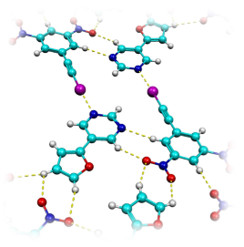Engineering Halogen Bond-based Materials

The operational efficiency of organic electronic devices such as OFETs and OPVs depends not only on the
molecular components but also on the supramolecular structure formed by the π-conjugated molecules. Recent
studies have incorporated solubilizing groups and acceptors as well as noncovalent interactions such as
hydrogen bonding as means to induce nanoscale architectures and enhance performance. However, many of
these devices still exhibit low-to-marginal performance due to poor manipulation (i.e., selection of
bonding partners and positioning within the molecular framework) of the self-assembling motif. Here we
utilize our expertise in supramolecular chemistry to exploit -hole interactions (e.g., halogen bonding,
XB) between novel organic small molecules and generate architectures needed to enhance optoelectronic
properties. Unlike hydrogen bonding and π-stacking, -hole interactions have been scarcely investigated—rarely
progressing beyond crystal engineering towards device fabrication. In turn, we seek transform the field of
organic and supramolecular chemistry as well as engineering by pioneering new avenues towards functional
materials based in halogen bonding.
Key words: solid-state chemistry, halogen bonding, sigma hole, supramolecular polymers
Representative work publication: Hierarchical Assembly of a Low Energy Gap pi-Conjugated Oligomer
via Synergetic Halogen and Hydrogen Bonding